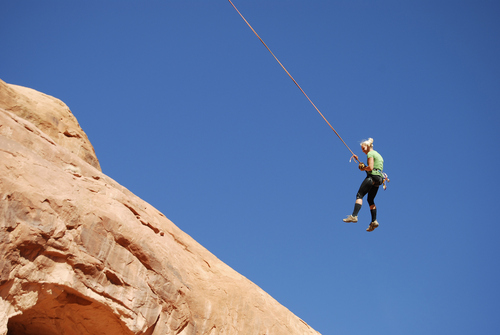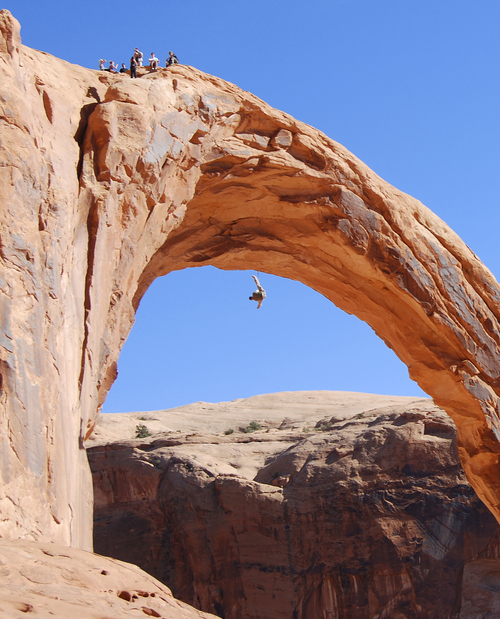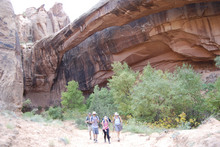This is an archived article that was published on sltrib.com in 2014, and information in the article may be outdated. It is provided only for personal research purposes and may not be reprinted.
After several years of negotiations, appraisals and renegotiations, a complex Utah land exchange between federal and state land-management agencies was approved Friday by the Bureau of Land Management.
The bureau will acquire 58 parcels, totaling 25,034 acres, primarily in Grand County and including recreation sites such as Corona Arch and Morning Glory Arch.
The state of Utah will acquire 34 parcels, totaling 35,516 acres and primarily in Uintah County, that have high potential for development.
Public comment will be gathered during the next 45 days.
But the sheer length of time it has taken to complete the deal has led many to wonder if federal rules governing such trades, which often enjoy near-unanimous support, are actually thwarting them.
The Utah Recreational Land Exchange, which Congress authorized nearly five years ago, has met hurdle after hurdle. One complication arose late last year when the National Park Service raised concerns about one parcel the BLM was trading to the Utah School and Institutional Trust Lands Administration, or SITLA.
The parcel is across the Green River from Dinosaur National Monument. Because it can be seen from the park's famed Dinosaur Quarry three miles to the north, NPS officials worried that potential energy development would degrade the monument's visitor experience.
The environmental group Grand Canyon Trust resolved the hitch by putting up $6,400 to lease the parcel's mineral estate for 10 years.
With that bump worked out, the BLM on Friday signed the Decision Record approving the exchange.
Interest groups that are usually at odds endorsed the deal. On the one hand, conservationists are pleased it removes the threat of development on SITLA inholdings inside Behind the Rocks and other wilderness study areas and scenic places. And the deal allows SITLA to consolidate its checkerboard holdings into larger tracts that are easier to develop without federal interference.
With the political winds filling its sails, why did the deal take years?
One word: process, says John Andrews, SITLA's general counsel.
Federal taxpayers got shafted in past exchanges, such as the acre-for-acre trade that rid SITLA of holdings in the Grand Staircase-Escalante National Monument. Watchdogs found the BLM gave up far more value than it received.
So now regulations ensure the federal government is getting fair-market value for the lands it sells or trades.
"In the recreation exchange, the pendulum has swung the other way and we've got every possible process, so it slowed it down," Andrews said. "There has to be somewhere in the middle where we don't over-encumber it with process, but have enough so there is public confidence."
Interior Secretary Sally Jewell agrees there is room for improvement, but there is no getting around the need for careful appraisals.
"The chopped-up nature of our lands, the sections within vast landscapes, isn't good for anybody, so managing more contiguous lands from the federal standpoint and the state standpoint makes all the sense in the world. The devil's in the details," Jewell said in an interview during her recent visit to Salt Lake City.
"We want to find a way forward that is more cost effective," she said, "and provides certainty to the developers and to those who want to set the land aside for conservation values, cultural resources, habitat and other needs."
But in Utah, the delays in the recreation lands deal, ostensibly necessary to protect U.S. taxpayers, may have put them at a disadvantage.
The deal initially proposed trading 35,516 federal acres, mostly in Uintah County with high oil and gas potential, for about 45,000 acres of scenic state-owned checkerboard across Grand County, located in such sandstone wonderlands as Sand Flats, Castle Valley and Pritchett Canyon.
But during the years it took to appraise the lands, the price of natural gas plunged, devaluing the BLM land proposed for the exchange.
Then appraisals for SITLA's Grand County sections were unexpectedly high, especially those with great views and stunning geologic features. For example, the Colorado-based appraiser Cushman & Wakefield valued the section harboring Corona Arch, a popular hiking destination near Moab, above $2.4 million.
The appraisals for the federal lands came in about $14 million short. To equalize the values of the exchanged lands, 36 SITLA parcels totaling 20,273 acres were dropped from the exchange, according to the BLM.
Dropping even more state acreage was not an option for resolving the eleventh-hour complication arising from BLM parcel No. 3, the 640-acre parcel within view of Dinosaur's popular quarry.
SITLA was never interested in the parcel, which was only included in the exchange at BLM's request, Andrews said. The federal agency wanted to transfer it to a rancher who owned the surrounding Thunder Ranch. The idea was to trade the land with the state, which would in turn sell it the rancher to incorporate into his grazing operation.
But in the intervening years, the rancher sold his land to an alfalfa exporter who was not interested in running cows and did not want the land.
Despite its lack of mineral potential, Parcel 3 was appraised at a hefty $960,000. Its mineral value was appraised at just $4.76 an acre, which made removing this obstacle to the land exchange rather inexpensive.
SITLA will lease the minerals for $1 an acre to the conservation group, whose board will be delighted to leave them in the ground.
How to comment on the swap
Appraisal documents and revised maps showing the parcels to be traded in the Utah Recreational Land Exchange will be available to the public for the next 30 days, from 7:45 a.m. to 4:30 p.m., Monday through Friday, at the Bureau of Land Management Utah State Office, 440 W. 200 South, Suite 500, Salt Lake City.
For the next 45 days, written protests can be sent or delivered to the attention of the BLM-Utah State Director at the same address or faxed to (801)539-4237. Telephone calls and email will not be accepted.
Maps and additional documents supporting the exchange, including the environmental assessment and Decision Record, are available online at http://blm.gov/drld.







